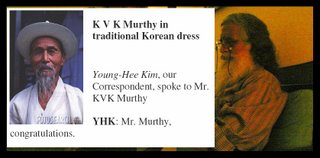I have held her up to my chin my violin
ah what music nestles within my violin!
turn the peg & tune up the string silence the crowd
clamor's ended when you begin my violin!
some take pleasure racing their cars into the hills
you I love to take for a spin my violin!
dust your surface taut is your bow hair of the horse
dark the rosin costly as sin my violin!
prayers when uttered some will say Om others Amen
you're my bhajan & my Amin my violin!
wise Professor! why is the raag wide as the sky?
can it hold both dunya & din my violin?
notesOm / Amen / Amin : three kindred forms of blessing marking the conclusion of a formal prayer (respectively from Hindu, Christian, and Moslem traditions)
bhajan : a devotional song (which, in Indian classical music, can also be expounded & explored instrumentally -- and which traditionally may optionally serve as the final item in a concert program)
raag (Hindi, from Skt.
raaga) : the modal & archetypal root structure underlying any given composition or improvisation in Indian classical music; the word is also used to denote any exposition of any given
raag (although, conceptually speaking, the
raag per se exists on a higher plane, or at a more abstracted level, than the particularlizing expression of its embodiment in any specific exposition. If seemingly a fastidious, academic distinction, in point of fact this is actually a lucid, basic distinction in the ubiquitous theory underlying classical traditions of Indian music. Among other things, this nuanced theoretical ground allows for the sophisticatedly conservative (while yet expressive, indeed expressionistic) approach to structured improvisation found in those traditions.)
dunya & din (Arabic/Urdu) : the world and the faith
[English
ghazal attempting to show strict attention to cadence (equivalent to the principle of
beher in traditional Urdu prosody). The poem's
maatla [first couplet] is based on
a sher [couplet] borrowed [stolen, but reworked a bit] from
Vasudev Murthy, the Bangaluru writer-violinist. (The 1st line of sher #2 is also semi-appropriated from the same source.) The
maaqta [final couplet] alludes to Dr. Murthy, via directly addressing him as "Professor" -- this title serving in the ghazal as (or, one could say, in lieu of) a
takhallus [poet's own pen-name]. Dr. Murthy is, it should be remarked, both a serious quasi-professional
humorist, and also a serious semi-professional
violinist. Although his own (possibly impromptu) faux-ghazal lines were perhaps penned with an element of comic intent [that is, with tongue, as the saying goes, firmly planted in cheek], I've laundered out such accidental-on-purpose wrinkles and ironed (which, ironically, removes the irony), creased & folded (formalized) this small tribute poem. In fine (and
en passant), let me additionally hat-tip Dr. Murthy's late music teacher, the esteemed Pandit
V.G. Jog (whose performance of Hindustani violin I recall with fondness from 20 years ago).]






